Contents
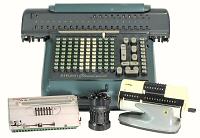
with Marchant 10DRX.
Contents |

|
| Multifix, Curta, and Alpina with Marchant 10DRX. |
The four-function mechanical calculators described elsewhere on this site are generally quite large and heavy machines. Some of the hand-cranked models were available with carrying cases, but they were never really suitable for portable use. During the 1930s several manufacturers produced smaller machines that could more easily be taken into the field. Calculators such as the Monroe "Executive" and the Brunsviga 10 were designed to be carried in a normal briefcase - in fact, the Monroe machine was originally supplied in an "executive" leather case. The first truly miniature four-function calcuators did not appear until the late 1940s, and only three brands ever achieved any significance - the Curta, the Multifix, and the Alpina.
The Curta (1948-1970) was the first and most successful of the three. The design and construction of its mechanism is a masterpiece of precision engineering, while the story of its development is the stuff of legend. The machine has acquired something of a "cult" status in recent years, but it was produced in quantity and is still readily available - at ever-increasing prices.
The Multifix calculator (1954-1960) was a miniature desk calculator designed and built by a sheet-metal company in Norway. It too has an ingenious mechanism, but is somewhat less of a joy to use. The machine is said to have been sold in 50 countries, but it is rare today, and almost forgotten.
The Alpina calculator (1960-61 and 1970) is a stylish and capable design which is clean, simple, and easy to use. It was produced by the Alpina typewriter company in Germany, but suffered several misfortunes and was discontinued after only one year. It was revived briefly in 1970, but only about 5000 machines were produced in total. The machine has almost a mythical status today, perhaps because of its rarity, or perhaps because of its connection to the BMW Alpina.
The achievements in miniaturisation by all three manufacturers are quite remarkable when compared to a typical desk calculator, but are even more so when compared to the first electronic calculators. The illustration shows an Alpina beside one of the first battery-powered portable calculators, the Sharp EL-8M from late 1970. All three mechanical calculators were smaller and cheaper than the electronic equivalent, and the two portable machines were also lighter. This situation was rather dramatically reversed by the introduction of Hewlett-Packard's pocket scientific calculator, the HP-35, in mid-1972. Mechanical calculators of all descriptions were soon displaced by the speed and convenience of the new electronic machines.
Curt Herzstark (1902-1988) was only 4 when his father Samuel Herzstark began production of the "Austria" calculator in Vienna. Curt grew up with calculators, studied mechanics, worked for a time at the Astra and Wanderer calculator factories in Chemnitz, and received several patents for improvements to the Astra machines. By the mid-1930s he was developing plans for a miniature cylindrical calculating machine. The family's Jewish ancestry brought great difficulties during the war years, but Herzstark managed to continue his calculator development under extreme circumstances in a German concentration camp. At the end of the war he was able to commence production of the machines at a new factory in Liechtenstein. The Resources section below has links to more detailed versions of the Curta story.
About 150,000 Curta calculators were built from 1948 to about 1970. They were very practical and useful machines, and were very popular, especially in the surveying industry. A book of tables and a Curta in its metal can could easily be taken into the field, allowing calculations to be completed and measurements verified without needing to return to the office. (Engineers, on the other hand, were generally satisfied with the three-figure accuracy of their slide rules). Many Curtas were purchased simply as curiosities or as "objets d'art", and some of these can still be found unused in their original packaging.
While the cylindrical arrangement is certainly unusual, it is not original or unique to the Curta. Some of the earliest calculating machines (eg the Hahn calculator of 1774) had sliders, dials, or stepped drums around the top and sides of a cylinder. Christel Hamman's US Patent 703785 from 1900 describes a machine which is very similar in concept to the Curta, having the same vertical setting sliders around the periphery, the single central stepped drum, and the liftable upper section containing the registers. Another cylindrical arrangement was used in Hamman's "Gauss" calculator, which was built commercially from 1905. Herzstark's undisputed achievement was to turn these earlier cylindrical concepts into a miniature mechanical masterpiece.
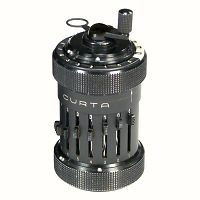 Curta Type 1 (early version), S/N 19722
Curta Type 1 (early version), S/N 19722
Digits: 8 setting, 6 counter, 11 accumulator
Dimensions: Body 60 dia. x 120H
Weight: 0.34kg
Manufactured: Contina Ltd, Liechtenstein, 1950s
An "early" Type 1 Curta from the 1950s. This version has a dome in the centre of the winding handle, and has a pressed-metal carrying can.
The lower section of the Curta body contains the setting sliders, the central stepped drum, and the carry actuating mechanism. The upper section contains the accumulator and counter registers and the clearing mechanism. Both registers have full tens transmission. The counter can be reversed manually (for division) by a small thumb tab on the side of the body.
Carriage shifts are accomplished by lifting the upper section (against a light spring) and rotating it to the next place. Either or both registers can be cleared by lifting the upper section and turning the clearing ring in either direction. The setting sliders are cleared manually by returning them to stops at the zero position.
The Curta has a uni-directional calculating mechanism, with subtraction accomplished by the addition of complements. Lifting the winding handle to a (slightly) raised position engages a set of complement steps on the central actuating drum and modifies the handling of the tens-carries. A non-return pawl in the base prevents the mechanism being rotated backwards.
The metal carrying can holds the machine firmly between foam pads
at the top and bottom, and is fully sealed against dust and moisture.
Early Type 1 Curta with metal can (28kb)
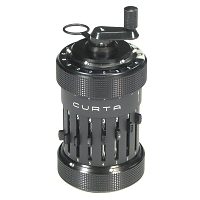 Curta Type 1 (late version), S/N 67129
Curta Type 1 (late version), S/N 67129
Digits: 8 setting, 6 counter, 11 accumulator
Dimensions: Body 60 dia. x 120H
Weight: 0.34kg
Manufactured: Contina Ltd, Liechtenstein, 1960s
A "late" Type 1 Curta from the 1960s. This version has a flat-topped handle and a plastic can. About 80,000 Type 1 machines were built, with serial numbers starting at 1.
Later Type 1 Curta with plastic can (28kb)
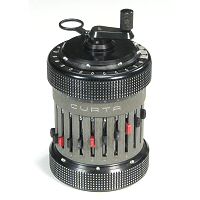 Curta Type 2, S/N 532925
Curta Type 2, S/N 532925
Digits: 11 setting, 8 counter, 15 accumulator
Dimensions: Body 75 dia. x 120H
Weight: 0.45kg
Manufactured: Contina Ltd, Liechtenstein, 1960s
The Type 2 Curta is basically the same as the Type 1, but with the diameter increased to accommodate the additional places in the registers. The version illustrated has a dull green body with colour-coded setting sliders. About 60,000 Type 2 machines were built, starting with serial number 500,000 in 1954.
Back about 1980, fellow calculator collector Mr. John Blackler of Sydney attended a disposals auction at the local Army barracks. Among the lots on offer he discovered a box containing 47 Curta calculators. He sought out the auctioneer and told him of his desire to purchase one or two of the Curtas, but was dismayed when the auctioneer later put them up as a single lot. However, fortune smiled when the auctioneer set the starting price at only $47, or $1 each.
As luck would have it, there was only one other bidder who quickly lost interest, and John soon found himself the owner of more Curtas than he had ever wanted - for the grand sum of $70.
While waiting in the queue to settle his account at the end of the auction, John found himself standing next to the other bidder. He introduced himself to the man and asked if he would be interested in sharing the lot. "No, not really", was the reply. "Anyway, what are they?"
Over the next 30 years John disposed of most of the Curtas by presenting them as gifts to colleagues and clients of his consulting engineering business. The last 14 came to me in 2013.
The Norwegian firm "Stansa" (or Den Norske Stansefabrik) was a sheetmetal pressing company established in Oslo in 1932. The factory moved from Oslo to Lillesand in 1946. The mechanism which was to become the Multifix was designed as a spare-time project by Swedish engineer Villy Spengberg, who joined the company in the late 1940s. Production commenced at Lillesand in 1954, and continued until about 1960. The Multifix business was small but reasonably successful, with about 70 people employed in the factory in 1957, and sales agents in 50 countries. Total production numbers are unknown, but the machines are quite rare today. The Stansa firm is still in business in Lillesand as Stansefabrikken A/S.
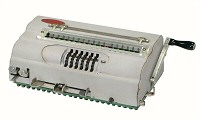 Multifix calculator, S/N 74068
Multifix calculator, S/N 74068
Digits: 6 rotor, 6 counter, 11 accumulator
Dimensions: Body 165W x 85D x 60H, overall width 200mm
Weight: 1.59kg
Manufactured: Stansa, Lillesand, Norway, 1954-1960s
The Multifix was designed as a miniature desk calculator, rather than as a pocket or hand-held machine. It was the only one of the three miniature calculators to offer a back-transfer function.
The internal view shows the main rotor with its setting thumbwheels at the front of the machine. The accumulator and counter registers are across the centre, with the accumulator on the left. Both registers have full tens transmission. Behind the registers is a clearing shaft, a tens-carry rotor, and a controlling camshaft. The levers at the front centre of the machine step the main rotor sideways through 6 decades relative to the stationary registers. The registers are viewed through a perspex magnifying lens on the top cover.
The Multifix has a uni-directional addition mechanism, but operates on a reciprocating rather than fully rotary basis. As the operating handle is drawn forward (through almost 180°) the entire register assembly moves forward to engage with the rotor. The dials are advanced directly by the setting wheels as the rotor turns. At the end of the forward stroke the registers drop back to engage with the carry rotor, which completes the tens transmission as the handle is pushed back to the starting position.
Subtraction is accomplished by the addition of complements. Each setting wheel has separate sets of teeth for the number and its complement. The small Subtract lever at the front of the right-hand side offsets the rotor by half a step so that the complement teeth will engage with the registers. The plain toothed wheels at each side of the setting wheels supply the additional 9s which are required to left-fill the rotor on subtraction. The counter register can be reversed manually (eg during division) by a small control tab which offsets the counter drive wheels relative to the main rotor. The control tab is located just to the right of the setting rings.
The clearing lever at the left front can be set to clear both registers or the counter alone as the handle is operated. The lever engages one or both of the concentric clearing shafts, which rotate their star wheels through a full turn during the forward stroke. When the register drops back on the return stroke, the star wheels rotate the dials until stopped by a missing tooth at the zero position. A push-button (marked C) adjacent to the clearing lever can be pushed in during the return stroke to clear the setting rotor as well.
The machine illustrated has an optional back-transfer function operated by the "R" button at the left front. The rotor is first positioned manually. The clearing lever is set to the centre (counter only) position, the handle is drawn forward, and the "C" button pressed. The counter and rotor are cleared on the return stroke. The clearing lever is then set to the right to clear the accumulator, the "R" button is pressed, the handle is drawn forward, and the button released. The result is transferred to the setting rotor as the accumulator is cleared on the return stroke.
Dr. Rudolph Bovensiepen established the Alpina company in 1949 in Kaufbeuren, a small town in Bavaria in southern Germany. The company's main business was with a range of portable typewriters that achieved a very solid reputation. In 1958 engineer Oskar Mildner completed a hand-built prototype of a miniature calculating machine. The machine entered mass production in 1960, but suffered from early manufacturing problems and was unable to compete with the well-established Curta. Only about 4000 Alpina calculators were built, and many remained unsold when production ended in 1961. The typewriter business was also in trouble, and was sold at about the same time. Typewriter production at Kaufbeuren ended in 1963.
It appears that the factory itself remained with the Bovensiepen family, for in 1965 the founder's son Burkard started a BMW tuning business at the same address and under the same Alpina name. Alpina is still a family-owned company, and is still very much in business as a manufacturer of high-performance BMW conversions.
Alpina Automobiles expanded rapidly and left the Kaufbeuren site in 1970. Oskar Mildner returned to the factory, restored the calculator machinery (which had sat idle for nine years), and produced a further 1600 machines. The last Alpina calculator (No. 6840) was made in 1971.
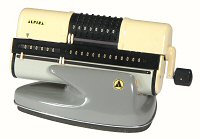 Alpina calculator, S/N 6726
Alpina calculator, S/N 6726
Digits: 8 rotor, 6 counter, 13 accumulator
Dimensions: Body 166W x 74D x 32H, stand 150W x 110D x 60H
Weight: Body 0.55kg, stand 1.6kg
Manufactured: Alpina Werke, Kaufbeuren, Germany, 1971
The body of the Alpina calculator is in two sections. The upper section (with the yellow plastic casing) contains the setting, actuating, and driving mechanisms. The lower section (with the grey aluminium casing) contains the counter and accumulator registers with their associated tens-carry and clearing mechanisms. "Carriage shift" is accomplished by sliding the upper section to the right against a spring-loaded detent. The winding handle folds flat against the case when not in use, and locks when the upper body is pushed fully home (to the left). The tens-carry mechanism extends across the full width of both registers, with automatic counter reversing on division. The reversing mechanism uses double-width numeral wheels and a sliding shutter, in a similar manner to the Brunsviga.
Operation of the Alpina is entirely conventional. The handle is turned clockwise to add and anti-clockwise to subtract. The setting rings are cleared by turning them back manually to a stop at zero. The counter and accumulator registers are cleared by a quarter-turn of the thumb-wheels at either end of the lower body (see detail view).
The Alpina was designed as a portable hand-held calculator, but could be mounted in an optional stand or base when required for desk use. The stand weighs over 1.5kg, and takes a firm hold of the lower section of the machine. The calculator can be released instantly by a push-button at the back of the stand. Several protective cases and carrying straps were available for portable use.
The machine illustrated is from the 1970-71 production, and is in
perfect working order.
Detail view (30kb)